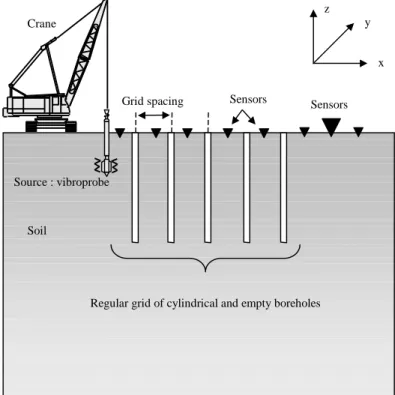HAL Id: hal-01343908
https://hal.archives-ouvertes.fr/hal-01343908
Submitted on 11 Jul 2016HAL is a multi-disciplinary open access archive for the deposit and dissemination of sci-entific research documents, whether they are pub-lished or not. The documents may come from teaching and research institutions in France or abroad, or from public or private research centers.
L’archive ouverte pluridisciplinaire HAL, est destinée au dépôt et à la diffusion de documents scientifiques de niveau recherche, publiés ou non, émanant des établissements d’enseignement et de recherche français ou étrangers, des laboratoires publics ou privés.
Seismic metamaterials
S Brûlé, E Javelaud, Sebastien Guenneau, S Enoch, Dimitri Komatitsch
To cite this version:
S Brûlé, E Javelaud, Sebastien Guenneau, S Enoch, Dimitri Komatitsch. Seismic metamaterials. ETOPIM9 book abstract, S. Guenneau, S. Enoch, Sep 2012, Marseille, France. �hal-01343908�
Seismic metamaterials
S. Brûlé1, E. Javelaud1, S. Guenneau2, S. Enoch2, D. Komatitsch3
1 Menard, Nozay, France,
stephane.brule @menard-mail.fr, emmanuel.javelaud@menard-mail.com
2 Institut Fresnel, CNRS UMR 7249, Marseille, France,
sebastien.guenneau@fresnel.fr, stefan.enoch@fresnel.fr
3 LMA, CNRS UPR 7051, Marseille, France,
komatitsch@lma.cnrs-mrs.fr
Abstract: This document presents the description of a preliminary large-scale seismic test held on
a soil metamaterial using vibrocompaction probes. The most simplistic way to interact with seismic wave is to modify the global properties of the medium, acting on the soil density and then on the wave velocity. The main concept is then to reduce the amplification of seismic waves at the free surface, called « site effects » in earthquake engineering. However, we develop here an other way to counteract the seismic signal by modifying the distribution of the seismic energy thanks to a “metamaterial” made of a grid of vertical, cylindrical and empty “inclusions” bored in the initial soil.
Site effect: The amplification of seismic waves at the free surface, namely « site effects » may strengthen the impact of an earthquake in specific areas (e.g. Mexico 1985). Indeed, when seismic waves propagate through alluvial layers or scatter on strong topographic irregularities, refraction/scattering phenomena may strongly increase the amplitude of the ground motion. It is then possible to observe stronger motions far away from the epicenter. At the scale of an alluvial basin, seismic effects involve various phenomena as wave trapping, resonance of the whole basin, propagation in heterogeneous media, generation of surface waves on the basin edges. 1
Structure damages due to seismic excitation is often directly correlated to local site condition in the form of motion amplification and/or soil liquefaction inducing ground deformation.
Standards: The European standard EN 1998-1 for the design of structures for earthquake resistance consider that mean value of the shear wave velocity Vs,30 for the first thirty
meters below the ground surface is reliable to relate site effects.
Some authors had shown that heavy densification works could indeed impact the Vs,30 and then, the
elastic ground response.2
Soils’ characteristics: An important fact is the low value of surface wave velocity, generated by natural seismic source or construction work activities, in superficial and under-consolidated recent material: less than 100 m/s to 300 m/s. In this geomaterials, considering 0.1 to 50 Hz frequency range, wavelengths of induced surface waves are shorter than P and S waves ones : from few meters to some hundreds of meters.
Analogy with electromagnetic cloaking principles: Considering precursory research work of Sir J.Pendry3 on the development of cloacking device which renders an object invisible to radar waves and recent results on acoustic domain4,5 , the preliminary objective of this seismic field test is to point out the analogy with electromagnetic domain by a quantitative approach. In theory, it seems realistic to intercede with seismic waves passing through an artificial anisotropic medium. However, soils could offer particular characteristics : non elastic behavior, high rate of signal attenuation, large-scale heterogeneousness, etc. These various uncertainties and the objective of modeling justify an in situ test to adjust soil’s parameters as shear modulus, quality factor, etc.
Source
Surface
Seismic material: A test zone constituted by a regular mesh of vertical cylindrical voids was carried out (figure 2).
Then length of columns is about 5 m and the grid spacing is smaller than 2 m. The mean diameter is 320 mm. The frequency of the vibrating source is 50 Hz with 14 mm of lateral amplitude in (x,y) plan.
Sensors are three components velocimeters (z,y,z) and 1 kHz sampling frequency. Due to the strong soil attenuation, the probe is close to the grid (1.5 m).
The experiment was carried out near the alpine city of Grenoble (France) last august.
The tested soil is a homogeneous silty clay. The thickness of the basin with similar deposits is up to 200 m. Results shall be published after analysis.
References
1. J.F. Semblat et al., Waves and vibrations in soils : earthquakes, traffic, shocks, construction works, 499 p (2009). 2. S. Brûlé et al., Could deep soil densification impact the seismic site effect ? 9th CUEE, 02-281, pp. 497-501 (2012). 3. J.B. Pendry, Negative refraction makes a lens, Phys. Rev. 85, 3966-3969 (2000).
4. M. Farhat et al., Broadband cloaking of bending waves via homogenization of multiply perforated radially symmetric and isotropic thin elastic plates. Phys. Rev., B 85, 020301 R (2012).
5. N. Stenger et al., Experiments on elastic cloaking in thin plates. Phys. Rev. Lett. 108, 014301 (2012).
Source : vibroprobe
Regular grid of cylindrical and empty boreholes
Grid spacing Sensors
Crane
Soil
Sensors
Fig. 2: Seismic testing device.
x y z
